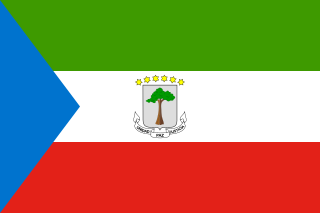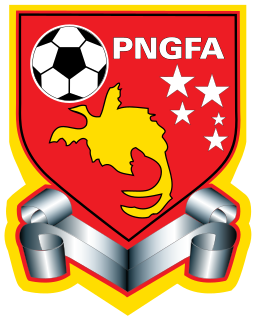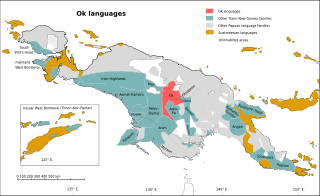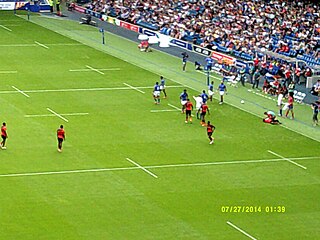
Equatorial Guinea, officially the Republic of Equatorial Guinea, is a country located on the west coast of Central Africa, with an area of 28,000 square kilometres (11,000 sq mi). Formerly the colony of Spanish Guinea, its post-independence name evokes its location near both the Equator and the Gulf of Guinea. Equatorial Guinea is the only sovereign African state in which Spanish is the official language. As of 2015, the country had an estimated population of 1,222,245.

Guinea, officially the Republic of Guinea, is a west-coastal country in West Africa. Formerly known as French Guinea, the modern country is sometimes referred to as Guinea-Conakry in order to distinguish it from other countries with "Guinea" in the name and the eponymous region, such as Guinea-Bissau and Equatorial Guinea. Guinea has a population of 12.4 million and an area of 245,860 square kilometres (94,927 sq mi).

Papua New Guinea, officially the Independent State of Papua New Guinea, is an Oceanian country that occupies the eastern half of the island of New Guinea and its offshore islands in Melanesia, a region of the southwestern Pacific Ocean north of Australia. Its capital, located along its southeastern coast, is Port Moresby. The western half of New Guinea forms the Indonesian provinces of Papua and West Papua.

Conakry is the capital and largest city of Guinea. A port city, it serves as the economic, financial and cultural centre of Guinea. Its population as of the 2014 Guinea census was 1,660,973 Originally situated on Tombo Island, one of the Îles de Los, it has since spread up the neighboring Kaloum Peninsula.

The guinea pig or domestic guinea pig, also known as cavy or domestic cavy, is a species of rodent belonging to the family Caviidae and the genus Cavia. Despite their common name, guinea pigs are not native to Guinea, nor are they biologically related to pigs, and the origin of the name is still unclear. They originated in the Andes of South America, and studies based on biochemistry and hybridization suggest they are domesticated descendants of a closely related species of cavy such as C. tschudii, and therefore do not exist naturally in the wild.

The Prime Minister of Papua New Guinea, is Papua New Guinea's head of government, consequent on being the leader of the party or coalition with majority support in the National Parliament.

The Territory of Papua comprised the southeastern quarter of the island of New Guinea from 1883 to 1975. In 1883, the Government of Queensland annexed this territory for the British Empire. The United Kingdom Government refused to ratify the annexation but in 1884 a Protectorate was proclaimed over the territory, then called "British New Guinea". There is a certain ambiguity about the exact date on which the entire territory was annexed by the British. The Papua Act 1905 recites that this happened "on or about" 4 September 1888. On 18 March 1902, the Territory was placed under the authority of the Commonwealth of Australia. Resolutions of acceptance were passed by the Commonwealth Parliament, who accepted the territory under the name of Papua.
Hebei GEO University, previously named Shijiazhuang University of Economics is a university in Shijiazhuang, Hebei, China. The total students are 19k to 20k with only 53 International students from Pakistan Afghanistan Ethopia Tanzania Ghana Rwanda and sudan. The university offer partial scholarships to the students also

The Papua New Guinea national football team is the national team of Papua New Guinea and is controlled by the Papua New Guinea Football Association. Its nickname is the Kapuls, which is Tok Pisin for Cuscus.
The Papua New Guinea national cricket team, nicknamed the Barramundis, is the team that represents the country of Papua New Guinea in international cricket. The team is organised by Cricket PNG, which has been an associate member of the International Cricket Council (ICC) since 1973. Papua New Guinea previously had One Day International (ODI) status, which it gained by finishing fourth in 2014 World Cup Qualifier. Papua New Guinea lost both their ODI and T20I status in March 2018 after losing a playoff match against Nepal during the 2018 Cricket World Cup Qualifier, a result that earned ODI and T20I status for their opponents.

Oksapmin is a Trans–New Guinea language spoken in Telefomin District, Sandaun, Papua New Guinea. It has been influenced by the Ok languages, and the similarities with those languages were attributed to borrowing in the classifications of both Stephen Wurm (1975) and Malcolm Ross (2005), where Oksapmin was placed as an independent branch of Trans–New Guinea. However, Loughnane (2009) and Loughnane and Fedden (2011) demonstrated that it is related to the Ok languages, though they share innovative features not found in Oksapmin.
The Papua New Guinea national rugby union team, nicknamed the Pukpuks,, played its first international in 1966, defeating Vanuatu 47-3. Papua New Guinea have not so far qualified for a Rugby World Cup. They participated in the Oceania World Cup qualifying tournaments for the 2007 and 2011 world cups, but did not qualify.

The Islands Region is one of four regions of Papua New Guinea (PNG) comprising the Bismarck Archipelago and north-eastern Solomon Islands Archipelago, located north-east of the mainland on eastern New Guinea island.

The Oksapmin languages are a family of a score of related Trans–New Guinea languages spoken in a contiguous area of eastern Irian Jaya and western Papua New Guinea. The most numerous language is Ngalum, with some 20,000 speakers; the best known is probably Telefol. They are:

The continent of Australia, sometimes known in technical contexts by the names Sahul, Australinea or Meganesia to distinguish it from the country of Australia, consists of the land masses which sit on Australia's continental plate. This includes mainland Australia, Tasmania, and the island of New Guinea. Situated in the geographical region of Oceania, it is the smallest of the seven traditional continents in the English conception.

New Guinea is a large island separated by a shallow sea from the rest of the Australian continent. It is the world's second-largest island, after Greenland, covering a land area of 785,753 km2 (303,381 sq mi), and the largest wholly or partly within the Southern Hemisphere and Oceania.

The Papua New Guinea national rugby sevens team competes in the Oceania Sevens, where they finished third in 2009, and fourth in 2010, 2015 and 2016.

Papua New Guinea competed at the 2012 Summer Olympics in London, from 27 July to 12 August 2012. This was the nation's ninth appearance at the Olympics. Papua New Guinea has appeared at every Summer Olympics since 1976, except the 1980 Summer Olympics in Moscow because of its partial support to the United States boycott.















